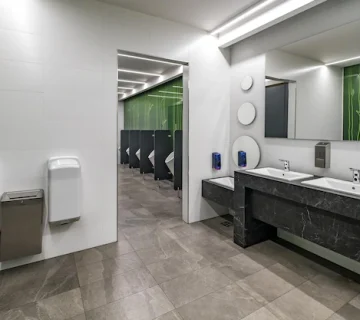A ceramic toilet is a bathroom fixture that is primarily composed of ceramic materials. It consists of a bowl, a seat, and a flushing mechanism. The use of ceramic in toilets is common due to its durability, resistance to water, and ease of cleaning. The ceramic material used is typically a type of clay that is fired at high temperatures to create a strong and non-porous finish.
Ceramic toilets are known for their versatility in design, making them suitable for various bathroom styles. They come in different shapes, sizes, and colors, allowing homeowners to choose options that match their preferences and the overall aesthetic of their bathrooms.
The flushing mechanism of a ceramic toilet can vary and may include gravity-feed systems, pressure-assisted systems, or dual-flush systems, each offering different levels of water efficiency. Additionally, ceramic toilets may come with features like concealed trapways, smooth glazed surfaces for easy cleaning, and technological integrations such as bidet functions or touchless flushing.
If you are in the market for a high-quality ceramic toilet, we invite you to explore our collection on our website. As one of the best ceramic distributors, we are committed to providing a diverse range of ceramic toilets that prioritize both durability and aesthetic appeal. Visit our website to discover the perfect ceramic toilet for your bathroom project, where quality meets style, and customer satisfaction is our top priority.

The Benefits of Using Ceramic Toilets
Ceramic toilets have been a staple in bathrooms for decades, and for good reason. The material’s durability, versatility, and aesthetic appeal make it a popular choice among homeowners. Here are several benefits of using ceramic toilets:
- Durability and Longevity
– Why: Ceramic is a robust and durable material, able to withstand daily use and potential impacts.
– Benefit: A ceramic toilet can last for many years without significant wear and tear, providing long-term value.
- Easy to Clean
– Why: The smooth, glazed surface of ceramic toilets is resistant to stains and allows for easy cleaning.
– Benefit: Maintenance is simplified, and regular cleaning can keep the toilet looking new and hygienic.
- Aesthetic Versatility
– Why: Ceramic toilets come in a variety of shapes, sizes, and designs, offering aesthetic flexibility.
– Benefit: Homeowners can choose a ceramic toilet that complements their bathroom style, whether it’s modern, traditional, or transitional.
- Hygienic Properties
– Why: Ceramic has non-porous properties, reducing the likelihood of bacteria and germs lingering on the surface.
– Benefit: A ceramic toilet contributes to a cleaner and more hygienic bathroom environment.
- Resistance to Chemicals
– Why: Ceramic toilets can withstand the use of common cleaning chemicals without losing their integrity.
– Benefit: Homeowners can use a variety of cleaning products without worrying about damaging the toilet’s surface.
- Water Resistance
– Why: Ceramic is inherently water-resistant, making it suitable for wet environments like bathrooms.
– Benefit: The material resists water damage and remains unaffected by regular exposure to moisture.
- Stain Resistance
– Why: The glaze on ceramic toilets creates a smooth surface that repels stains.
– Benefit: Stains from hard water, minerals, or other substances are less likely to adhere to the surface, maintaining the toilet’s appearance.
- Variety of Styles and Shapes
– Why: Ceramic toilets are available in a wide range of styles, including two-piece, one-piece, wall-mounted, and corner designs.
– Benefit: Homeowners can choose a toilet that suits their bathroom layout and personal preferences.
- Heat Resistance
– Why: Ceramic can withstand temperature changes without warping or cracking.
– Benefit: Fluctuations in bathroom temperature, especially due to hot water use, do not negatively impact the structural integrity of the toilet.
- Cost-Effective
– Why: Ceramic toilets are often more budget-friendly compared to other materials.
– Benefit: Homeowners can achieve a durable and aesthetically pleasing toilet without breaking the bank.
- Eco-Friendly
– Why: Ceramic toilets are made from natural materials, and many manufacturers incorporate eco-friendly practices.
– Benefit: Choosing a ceramic toilet can align with environmental sustainability goals.
- Customization Options
– Why: The malleability of ceramic during the manufacturing process allows for a variety of design options.
– Benefit: Homeowners can choose toilets with unique patterns, textures, and finishes, adding a personalized touch to their bathroom.
- Non-Allergenic
– Why: Ceramic is a non-allergenic material.
– Benefit: It is a safe choice for individuals with allergies or sensitivities, as it does not harbor allergens or irritants.
- Excellent Heat Retention
– Why: Ceramic has good heat retention properties.
– Benefit: This ensures that the toilet bowl stays at room temperature, providing comfort to users, especially during colder seasons.
- Widely Available
– Why: Ceramic toilets are widely available from various manufacturers and retailers.
– Benefit: This accessibility makes it easy for homeowners to find replacement parts if needed or upgrade their toilet when desired.
In summary, the use of ceramic toilets offers a combination of durability, easy maintenance, aesthetic flexibility, and cost-effectiveness. These benefits make ceramic toilets a popular and practical choice for bathrooms in homes and commercial spaces alike.

Installing a Ceramic Toilet
Installing a ceramic toilet may seem like a complex task, but with the right tools and step-by-step guidance, it can be a rewarding DIY project. Follow this comprehensive guide for a successful installation of your ceramic toilet:
- Gather the Necessary Tools and Materials
– Tools: Adjustable wrench, screwdriver, pliers, hacksaw, putty knife, carpenter’s level.
– Materials: Wax ring, toilet bolts, nuts, washers, water supply line, toilet.
- Turn Off the Water Supply
– Why: Prevent water spillage during the installation.
– How: Locate the shut-off valve near the base of the toilet and turn it clockwise to stop the water supply. Flush the toilet to drain the remaining water from the tank and bowl.
- Remove the Old Toilet
– Why: Clear the space for the new toilet installation.
– How: Disconnect the water supply line and remove the nuts securing the toilet to the floor bolts. Lift the old toilet off the flange, being cautious of any remaining water. Remove the wax ring and clean the flange.
- Inspect the Flange and Floor Level
– Why: Ensure a stable base for the new toilet.
– How: Inspect the flange to ensure it’s in good condition. Check the floor level and make any necessary adjustments to ensure a stable base for the new toilet.
- Install the Wax Ring
– Why: Create a watertight seal between the toilet and the waste pipe.
– How: Place a new wax ring onto the flange, making sure it is centered. The wax ring should be thick enough to compress when the toilet is installed.
- Position the Toilet
– Why: Proper alignment ensures a secure fit.
– How: Carefully lower the new toilet onto the wax ring, ensuring that the bolts on the flange pass through the mounting holes on the toilet base. Press down firmly to set the wax ring in place.
- Secure the Toilet
– Why: Prevent instability and potential leaks.
– How: Place washers and nuts onto the bolts, tightening them evenly to secure the toilet to the floor. Be cautious not to overtighten, as this can damage the toilet or the flange.
- Attach the Water Supply
– Why: Reconnect the toilet to the water supply for flushing.
– How: Connect the water supply line to the fill valve on the bottom of the toilet tank. Hand-tighten the nut, and then use a wrench to give it a quarter turn to secure it.
- Check for Level
– Why: Ensure proper functionality and drainage.
– How: Place a carpenter’s level across the toilet bowl and adjust as needed to ensure the toilet is level in both directions. A level toilet prevents issues with flushing and maintains proper drainage.

- Secure the Toilet Seat
– Why: Provide a stable and comfortable seating surface.
– How: If the toilet seat is not pre-installed, follow the manufacturer’s instructions to attach it securely. Use the provided hardware and a screwdriver to complete this step.
- Turn On the Water Supply
– Why: Restore water flow to the toilet for flushing.
– How: Turn on the water supply valve and let the tank fill. Check for any leaks around the base, water connections, and at the fill valve. Tighten any connections if needed.
- Flush and Check for Issues
– Why: Confirm proper flushing and identify any potential problems.
– How: Flush the toilet several times to ensure proper flushing and refilling. Check for any unusual sounds or leaks during the process.
- Seal Gaps
– Why: Prevent water damage and maintain aesthetics.
– How: Apply a bead of waterproof caulk around the base of the toilet to seal any gaps between the fixture and the floor. This helps prevent water damage and keeps the installation aesthetically pleasing.
- Dispose of the Old Toilet Responsibly
– Why: Follow environmental guidelines for responsible disposal.
– How: If disposing of the old toilet, check local regulations for proper disposal methods. Some municipalities may have specific guidelines for toilet disposal.
Congratulations! You’ve successfully installed your ceramic toilet. Remember to follow the manufacturer’s instructions throughout the process, and enjoy the benefits of a newly installed and functional fixture in your bathroom.




No comment